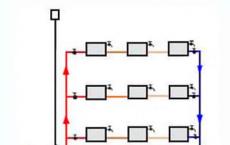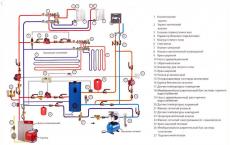Forced heating of a private house. Modern home heating systems - basic schemes and differences
Arranging his life a man has long sought to create a cozy atmosphere in his home. One of the criteria for good health is comfortable temperature in the room. For these purposes, people use different heating options. Water heating is still one of the most demanded systems. It has long been used successfully in many countries. The most popular of them - the heating system with forced circulation allows you to create comfort and coziness in houses of different size and number of storeys.
In heating systems with natural circulation, the heated coolant rises up the pipeline. Passes through the heating elements, cooling down, and returns to the heating element. The low efficiency of such a system makes the pump use to improve fluid flow. That is why a similar kind of heating is called a system with forced circulation.
The pump, taking the coolant on one side, sends it to the heating element and then through the system, without increasing the pressure. Therefore, the principle of natural displacement of liquids of different temperatures does not apply here. With the help of the pump, the heat carrier moves in the desired direction without losing heat. By controlling the speed of the pump, it is possible to control the amount of heat produced.
Advantages and disadvantages of such a system
Due to the use of the pump, the system with forced circulation has several advantages:
- the operation of the forced circulation heating system does not depend on the diameter of the pipes used;
- the use of inexpensive pipes of smaller diameter when installing the system allows to save on materials;
- due to the absence of a temperature difference, the service life of the structural elements of the system increases;
- the possibility of independent temperature control in each room;
Such a system has its drawbacks:
- the pump generates a small noise during operation;
- due to the use of a pump powered by electricity, the operation of the system depends on the power supply.
Circuits of heating with forced circulation
Depending on the number of pipes and the method of their installation, the forced circulation circuit is: one-pipe and two-pipe, with top and bottom wiring. We will consider in more detail the following.
Single-pipe heating systems
Horizontal. Single-pipe horizontal heating systems are mainly used for houses of small length or industrial buildings. The heat carrier, falling into the main riser, is distributed between the horizontal risers and passes successively through all radiators. Cooled and returned on the return line.
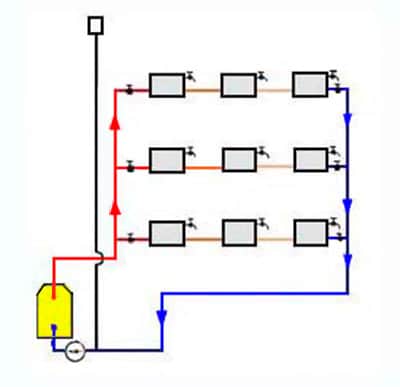
Each radiator has a bleed valve. The temperature of the heating elements is regulated by a stop valve, which is placed at the beginning of the system on each floor.
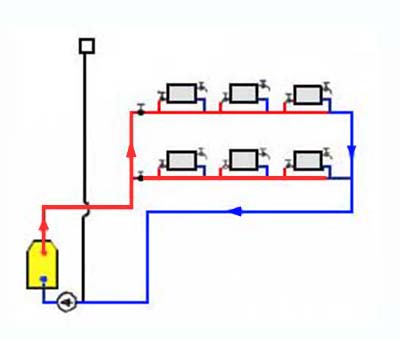
Vertical. In vertical single-pipe systems, the coolant falls directly to the upper floor. Further on the risers flow into the radiators of the upper floor. After that, the liquid flows along the feeding risers into the heating elements of the lower floor. And so on down to the bottom. The disadvantage of this scheme is the uneven heating of radiators on the lower and upper floors.
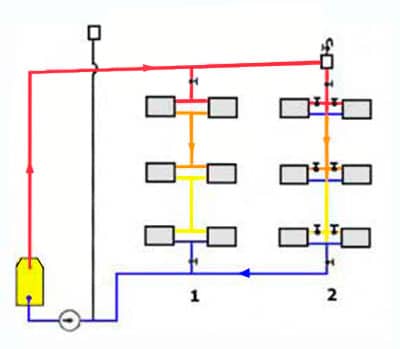
Single-pipe vertical heating system: 1-flow, 2-with closing areas
Example device single-pipe heating system in a private house:
Two-pipe heating systems
Horizontal. Horizontal systems with forced circulation are used in private house-building. They are:
- dead-end;
- associated;
- collector.
In the first, each subsequent heating element in the direction of fluid motion is at a farther distance from the heating element. This leads to an increase in their circulation circuit and makes it difficult to control the operation of the system. In passing systems, the equality of the circulation circuits facilitates the adjustment of the process, but increases the length of the pipeline. And this in turn leads to additional waste while installing the equipment.
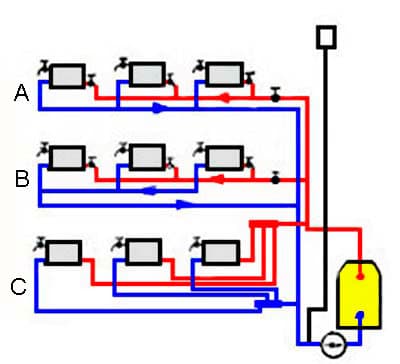
Two-pipe horizontal system: A - deadlock,
В - passing, С - collector
The device of collector systems means individual connection of each heating element. Due to this, the radiators are evenly heated. But such a system is associated with large waste during installation, in view of the large expense of pipes.
Vertical, with bottom wiring. In two-pipe systems with forced circulation, the liquid enters the heating element (boiler) by means of a pump. Then the coolant enters the supply pipeline and is distributed along the system, and then into the heating elements. After giving up heat, the cooled liquid on the return line through the expansion tank and the pump returns to the boiler.

Vertical, with top wiring. Trunk pipelines of two-pipe systems with top wiring are located above the heating elements under the ceiling of the upper floor or in the attic. The water is circulated by pump from the heating boiler upwards and through the risers to the heating elements. After giving up heat, the liquid enters the return line, located above the floor of the lower floor or in the basement.
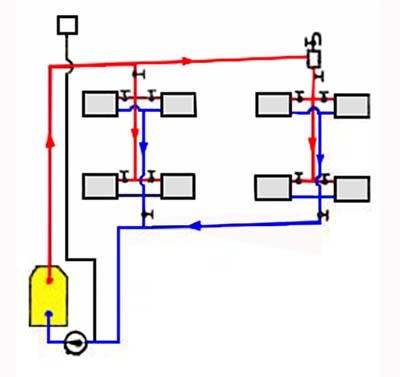
Rules of the equipment of the heating system with forced circulation
That the system worked long and smoothly it is necessary correctly to execute installation.
- Due to the absence of evaporation of liquid in the system, it is necessary expansion vessel installation . It compensates for thermal expansion. It is connected to the return line.
- Circulation pump also connect to the return line. It is here that the least heating of the liquid takes place. Therefore, hot fluid does not come into contact with the pump, and this prolongs the life of the unit.
- The use of a smaller diameter in the wiring reduces the volume of the circulating fluid. And this not only reduces installation costs, but also increases the economy and service life of the expansion tank.
- Modern boilers with automatic temperature control will help economize the use of fuel and adjust the temperature depending on the time of day.
The heating system with forced circulation is much more efficient than the system with natural circulation. They make it possible to warm up the premises more quickly and with less loss. Installed systems with natural circulation can be completely remodeled by installing a circulating pump and expansion tank into the return line. This will help maintain a comfortable temperature in the room without loss, even in winter.
Considering the arrangement of the heating system for a single-storey house, the owner has to choose between two absolutely opposite options: heating with natural and forced circulation. In the first case, the rate is made for basic physical laws, and in the second case for special equipment. And for a variety of reasons, the second option is often found in the favorites. Why is it so remarkable? To find the answer, we offer to understand the principles of operation and specificity of the system with forced circulation, as well as get acquainted with the rules and video of the organization of different heating schemes with their own hands.
Principal differences
The main feature of the considered is the presence of a pump. He receives and sends it further according to the scheme to the heating devices. Here, the physical principle of the natural motion of the liquid does not play a role because of the difference in the temperature indices - the coolant moves in the required direction forcibly with the given parameters of speed, temperature and pressure without loss of heat. The standard heating system includes the following components:
- boiler;
- pump;
- expansion tank;
- radiators;
- pipes;
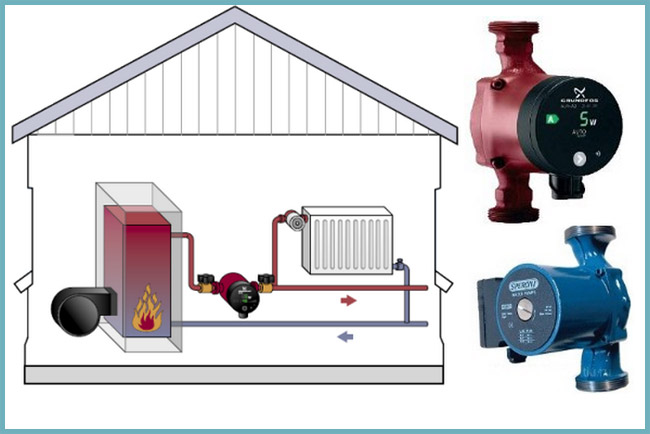
Heating system with pump
- connecting fittings;
- air outlets;
- ball and cork cranes;
- filters;
Council. Choosing equipment for the operation of a heating system in a particular single-story house, three important factors must be considered: the capacity of the boiler used, the length of the pipeline, the planned rate of movement of the coolant.
There are two schemes of a heating system with forced circulation: one-pipe and two-pipe.
Single-pipe heating system
The main difference between a single-pipe heating system is the combination of two lines: supply and return. This makes it possible to use fewer pipes and accompanying equipment.
In a single-storey house, a horizontal or vertical version of a single-pipe heating system may be used. Both are suitable mainly for small houses.
The horizontal system works in this way: the coolant enters the main line and, distributed along the horizontal supply risers, evenly moves to all the radiators.
The vertical single-tube system is characterized by the fact that in it the coolant moves along the supply risers from the top to the bottom: first from the boiler it enters the main pipeline located in the attic or attic, and from it to the batteries of the ground floor.
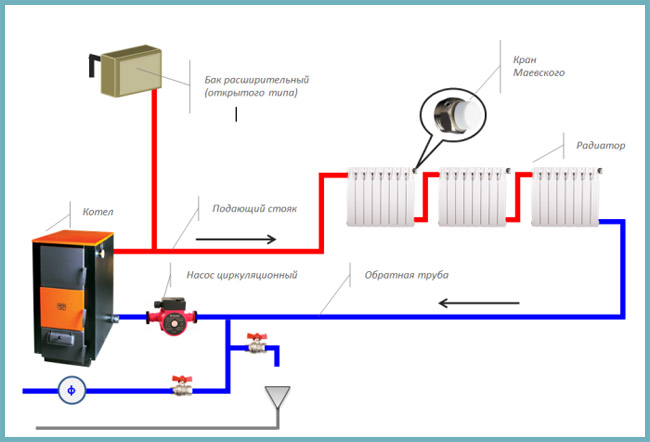
Single-pipe heating system
In both cases, after cooling, the coolant is returned back to the heating boiler - it flows there via a combined return line through the pump unit.
Two-pipe heating system
The two-pipe system is distinguished by a distinction between the supply and return main pipelines. It is represented by two types: horizontal and vertical schemes. Additionally, both these schemes are divided into several more types.
The horizontal scheme is performed in three variations:
- Dead-end - means that each subsequent battery in the course of moving the coolant is located farther from the boiler, which increases the circulation circuit and reduces the efficiency of control over the heating system.
- Passing - has equal circulation contours, which increases the length of the pipeline, but allows you to facilitate and improve control over heating.
- Collector - involves a separate connection of each radiator, which ensures a uniform heating, but requires the use of a large number of pipes.
The vertical scheme is performed in two variations:
- With the lower decoupling: first the coolant is fed through the pump into the supply pipes, through them to the batteries, and after the heat is released - again through the return line to the boiler.
- With the upper denouement: the coolant is fed to the main pipeline, located in the attic, attic or under the ceiling, then from there goes through the supply pipes to the batteries, and then goes to the return line of the pipeline laid in the basement and returns to the heating boiler.
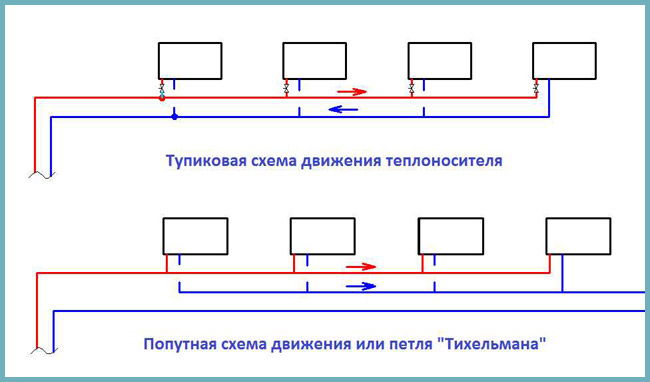
Two-pipe heating system
Advantages and disadvantages
Due to the use of the pump, the heating system with forced circulation type has a considerable range of advantages:
- The possibility of using pipes of any diameter - the quality of the system's operation is not tied to the diameter of the pipes, since the pump guarantees a constant velocity of the coolant moving and the same heating of all zones of the system, regardless of the size of the used products. This allows to ensure the uninterrupted operation of the system even with inexpensive pipes of reduced diameter.
- Simplified installation - there is no need to strictly maintain a certain angle of laying pipes, as in the case of a system with a natural type of circulation, which makes it possible to perform the installation of equipment yourself.
- Independent temperature control - it is possible to set a specific temperature in each separate room of a single-storey house, regardless of the temperature in the neighboring room.
- Absence of temperature differences - thanks to the pump in the system there are no significant temperature fluctuations, which significantly increases the service life of all devices and units.
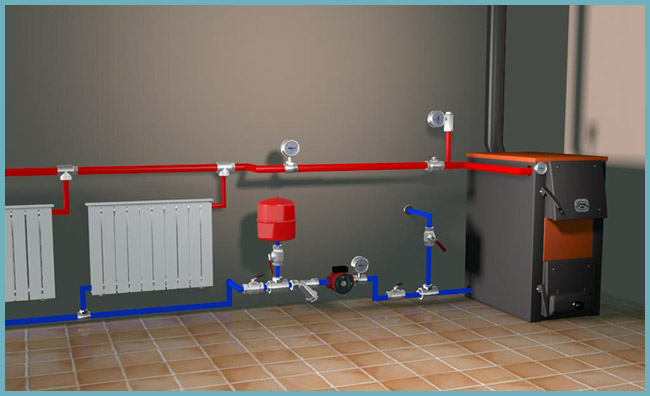
Piping heating pipes in a private house
Among the main disadvantages:
- Dependence of heating on electricity supply - due to the use of a circulating pump, the heating system requires a mandatory connection to the mains.
Council. The pump can be protected from emergency power outages by using an uninterruptible power supply.
- Uncomfortable noise level - the operation of the pumping unit is accompanied by a not very pleasant noise.
Without a doubt, the heating system with forced circulation in many respects exceeds the option with a natural movement of the coolant. That's why it is most often chosen for single-storey houses. But for this choice to bring only positive results, it is important to organize heating correctly, so carefully study the available schemes of the device system - they are all in front of you.
Diagram of a single-pipe heating system: video
Heating system for a private house: photo
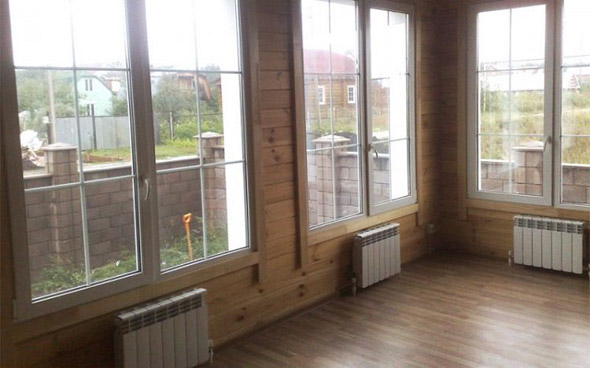
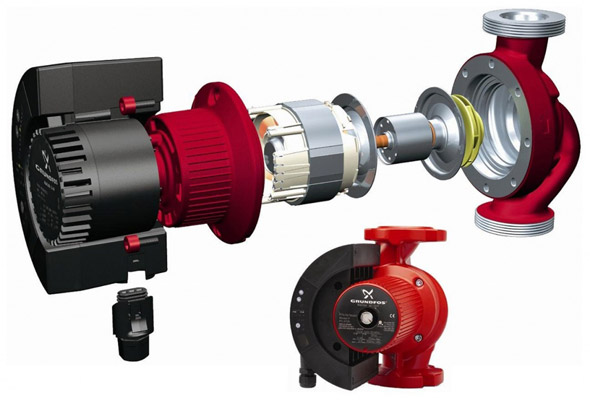
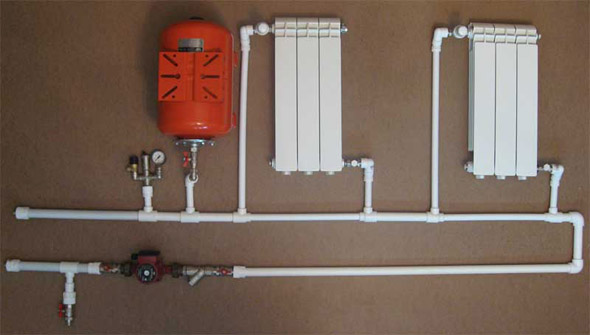

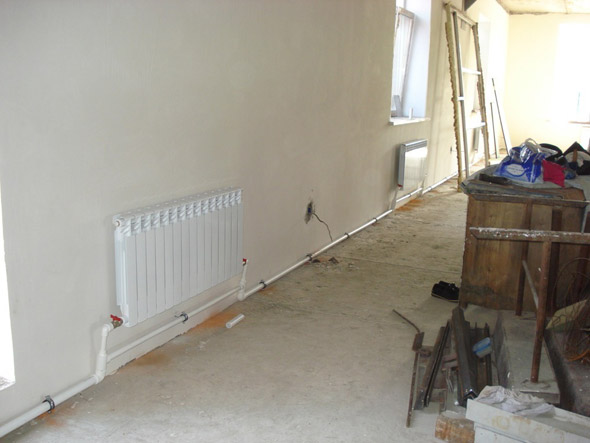
The efficiency of the system with forced circulation of the coolant is achieved due to the ability to monitor and set the desired level of heating in each room and for each radiator. From the point of view of the owner, this nuance sometimes acts as a decisive factor in choosing the type of system.
Turning to other advantages of a forced circulation heating system for a single-storey house, it is worth noting:
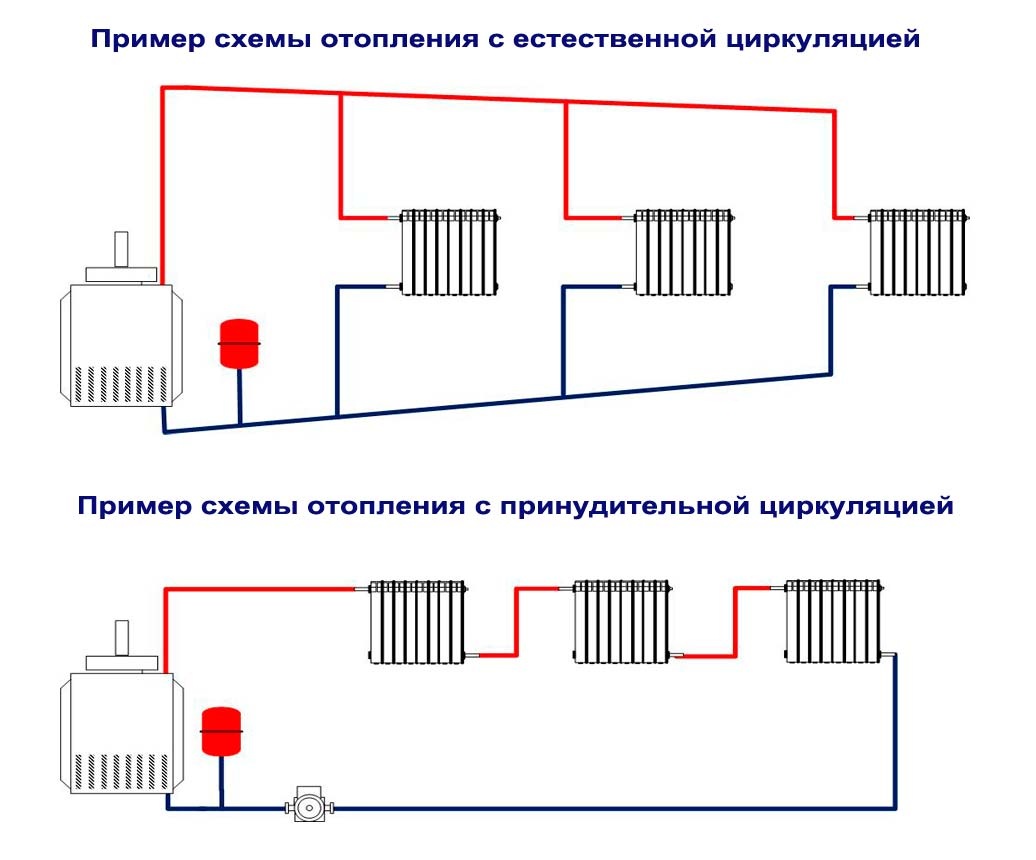
Analyzing the drawbacks of the scheme with forced circulation, it is worth mentioning the main ones. First of all, in the absence of electricity, there will be no heating in the house. It is not recommended to use such a system if the area is characterized by interruptions with electricity. Experts note another drawback - the creation of noise during the operation of the circulation pump. But it can be solved. For example, installing a boiler and pump in a non-residential room, boiler room, basement.
Choosing modern versions of boilers, it is worthwhile to know that almost all of them are equipped with a built-in pump. He works, of course, not noiselessly, but not so loud as to be considered a problem. For example, the hood in the kitchen makes a lot more noise.
The main components of the system

On the type of the boiler depends the need to install the pump and expansion tank. All modern models are equipped with them (except for solid fuel).
To draw a diagram of heating a single-storey house, you need to determine its main components. First, pick up the boiler. Type the boiler based on the availability of resources (gas, solid fuel, combined, electric). If possible, it is worth giving preference to equipment with a closed combustion chamber (except solid fuel) and a turbocharged chimney. This is the safest and less labor intensive in maintenance and operating conditions. If you need to ensure the heating of water for housekeeping needs, it is worth taking a two-circuit.
The calculation of power takes place taking into account all possible heat losses. But the minimum parameter can be calculated by the area: 10 kW for a house in 100 sq.m. Usually take with a margin for hidden heat loss (better to add from 20%). Add 50% of the initial value to the DHW circuit.

When calculating the power, one must take into account the heat loss
If the boiler has an expansion tank and a pump, they do not need to be installed separately. Otherwise, the pump is selected according to the following parameters:
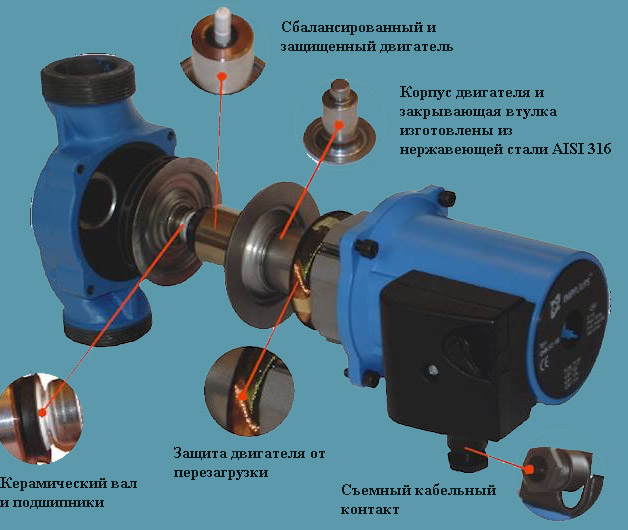
Today there are two main types, which differ in the way of installation and the device, the so-called dry and wet type pumps. In terms of work efficiency, they do not have any significant differences.
For a small single-storey house (up to 200 sq. M.) There will be enough equipment with a capacity of up to 3.5 m3 / h and up to 0.4 atm pressure. Installation of the pump is recommended to carry out reverse flows on the pipe, since it contains already cooled coolant. This will extend its service life.
Often, sellers or specialists note that modern pumps contain ceramic seals that can withstand up to 110 ° C, but take precautions will not be superfluous.
Types
When designing a scheme for a single-storey house, it is worth considering the features of the versions of the systems with forced circulation.
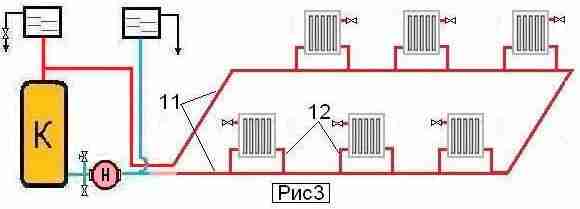
If you choose a single-pipe system, you should consider the possibility of disconnecting each battery (for repairs, adjusting the temperature in the room)
This is relatively rarely used because of low efficiency. It represents one highway along the walls, passing under all the radiators. From each of them, nozzles are installed in it, through which the supply and removal of the coolant takes place. As the hotter coolant enters the first radiators, giving them some of the heat, the latter approaches the last cooled down already. As a result, heating the house will be uneven, and the farthest from the boiler rooms will heat up much longer. Best of all, this scheme is suitable for a single-story house in a small area, as it will reduce the cost of installation. There is another version of the single-tube scheme: when the radiator cuts into the pipe. The downside of this method is the impossibility of covering one of the radiators so that the entire system can not be stopped.
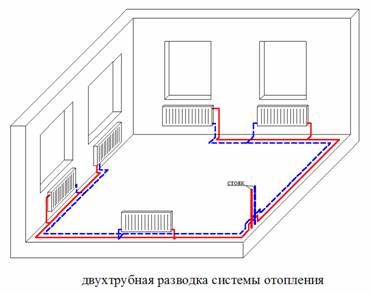
Choosing a two-pipe system, you can connect the radiators by any means: diagonal, lateral, lower connection
Scheme of a two-pipe system for heating a single-storey house
This is the optimal heating scheme, which is suitable for a single-storey house of a large area, as well as for a two-storey building. Its meaning lies in the separation of heat-carrier flows: a pipe is installed separately for supplying hot water to the radiators and the second one for removing the cooled one. From the shortcomings of the scheme, you can identify a large consumption of material, since it will be necessary to mount two separate lines along the entire perimeter of the house. But the advantages of the system are more significant: the difference in the temperature of the coolant, which is suitable for the first and last radiator, is not significant. Depends on the size of the house and the number of batteries.
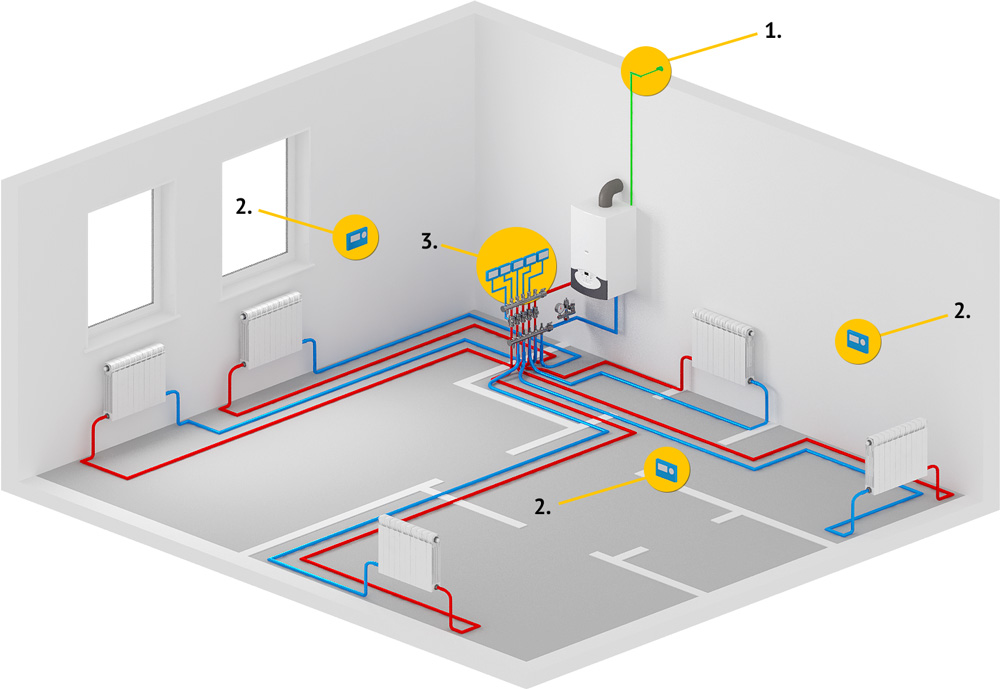
The most effective system, but also the most costly, requiring compliance with certain conditions and a professional approach at start-up
Collector (beam). This scheme will ensure the supply of the most hot coolant to each battery. For a single-storey house is chosen rarely, only with a large area, but the collection system is most appropriate for a two-story house. It represents the supply of the coolant through one pipe, from which the branch branches into each room and diverges by the radiators. It is allowed in some cases to apply a scheme for only one room, for example, with a large number of batteries. But this system often involves laying in the floor, which is not always possible, and costly due to a large consumption of material.
Radial and two-tube systems can be combined, it is also possible to draw in the scheme the use of a warm floor system in one or more rooms.
In recent years, gravity systems are giving way to a more "advanced" one. Many people ask whether a heating system with forced circulation can be installed by hand.
These are now installed in all new buildings without exception, and this is how heating systems look inside the apartment houses.
The basis of this scheme is forced circulation due to the difference in pressure, which is carried out by the pump, the latter in this case is called circulating.
Benefits
- The rooms that need to be heated are heated much faster and, accordingly, the necessary air temperature in the room is reached much faster;
- Heating devices in the network are heated evenly. With natural circulation, the temperature of the radiators depends on the distance to the boiler;
- There is an opportunity to regulate the heating in the network on separate sections, and also to overlap part of the circuit. In addition, it is possible to change the layout and installation of the entire building's heating system;
- Forced heating prevents obstruction in the pipelines of the heating system;
- The use of the pump makes it possible to make the entire system closed by incorporating a membrane expansion tank into the circuit. A consequence of this is a reduction in the evaporation of water in the system;
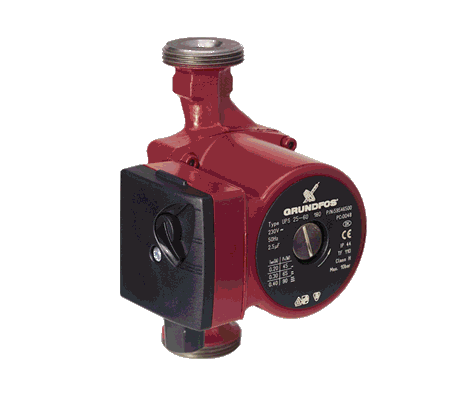
- The installation of the entire system is simplified. There is no need to carefully calculate the height, length, diameters and slope of pipes for normal circulation;
- The heating circuit with forced circulation saves heat. Consequently, fuel consumption is reduced;
- The use of smaller diameter pipelines offers savings in installation. With the same length, the price for pipes of smaller diameter is lower than for pipes of larger diameter;
- In closed systems, the difference in temperature between the inlet and outlet of the heating boiler is much smaller. Due to this, the life of the boiler equipment is increasing.
Disadvantages of closed systems
Water heating with forced circulation has drawbacks:
- A significant drawback of this design is the dependence on power supply. Solving this problem can only be achieved by providing the heating system with an independent, uninterrupted source of electricity;
- The circulating pump itself - although not very expensive, still has a certain cost, which makes the installation of the system more expensive. In addition to the pump, it is necessary to purchase also the armature for its clipping in the system and normal operation;
- The operation of the pump requires a constant cost of electricity.
Selecting a circulation pump
Before choosing a pump, it is necessary to take into account a number of factors:
- Type of coolant (antifreeze or water);
- Coolant temperature;
- Pipeline characteristics (material, diameter, length, etc.);
- Heating devices (radiators and radiators), as well as their technical characteristics (heat transfer area, material, construction);
- Shut-off valves and regulating elements;
- The presence and nature of the automatic control system.
Important!
The general principle that should be followed when choosing a circulation pump is as follows.
Its performance should provide a three-fold rotation of the coolant in the system per hour of operation at full capacity.
Only if this condition is met will good circulation.
Installation of the circulation pump
What are the main points to take into account when switching the circulation pump into a circuit?
They are listed below:
- The pump is mounted on the return main pipeline. With this connection scheme, the service life of all devices in the system is extended;
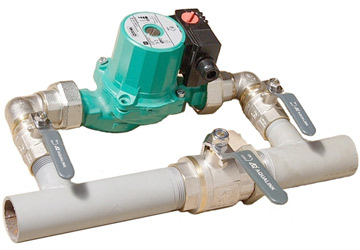
- When connecting the pump in front of it to the circuit it is highly recommended to include a filter that protects the impeller from breakage due to foreign objects (scale, scales, solid particles, foreign objects, etc.);
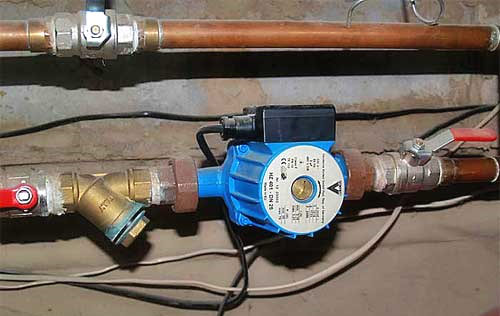
- During the connection, the pump must be deaerated. For this purpose, a special screw is provided in the pump design;
- The instruction that is attached to the pump has a calculation of the power consumption depending on the performance;
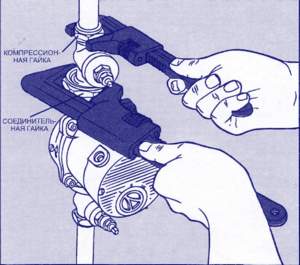
- The designation of the pump indicates the diameter of the pipeline to which it can be connected (in millimeters) and the pressure that this pump generates (in decimeters of the water column).
For example, marking GPD 25-100 means that this pump is connected to a pipe with a diameter of 25 mm and creates a pressure of 10 m.

- When choosing a pump, pay attention to the power consumption;
- The design should be strong;
- The equipment should not be demanding for maintenance for a long time;
- The pump must be durable.
An example of approximate calculation of pump power
- For, which gives a capacity of 4 m3 per hour and head to 0.5 atmospheres;
- For a house with a total area of 500 m2, a pump of 6 m3 per hour and a pressure of up to 0.7 atmospheres is required;
- For a house of 700 m2 the capacity of the pump should be 10 m3 per hour, and the head - up to 0.8 atmospheres.
In addition, when choosing a circulating pump, it is necessary to take into account its ability to independently regulate the engine speed. If such a function is present, this increases the service life of the equipment and reduces power consumption.
It is also worth considering the fact that the forced heating system does not work if there is air in the system (see). For this reason, it is necessary to take into account the inclusion of automatic airlifts in the chain.
The video shows how you can install the pump yourself:
conclusions
In the heating scheme described above, the same principles of installation and calculation are used, as in the gravity diagram. Due to the inclusion in the pump circuit, it is not necessary to comply with all deviations in the closed heating system.
The inclusion of the pump in the return line allows prolonging the operation of all parts of the heating system. The use of forced circulation makes it possible to operate heating systems for a long time.
- serial and parallel. Sequential connection is achieved by means of single-pipe wiring, parallel - using a two-pipe heating system.
One- and two-pipe heating systems
With a parallel wiring (two-pipe private house), each battery receives a heated coolant from the supply pipe and returns to the "return". Pipes for installation need twice as much, but there is an opportunity on each battery, reducing the temperature in uninhabited rooms and thereby saving fuel.
A special case of such a connection is the beam scheme, we will not consider it here due to the complexity of the adjustment and the high consumption of materials.
Scheme of 1- and 2-pipe heating system
In a sequential wiring (single-pipe heating system), the coolant from passes consistently all, giving away each part of the energy.
This is the simplest scheme, requiring the least amount of materials. Bad in it is that the radiator nearest to the boiler will be the hottest, the farthest, the coldest.
In addition, it is not possible to regulate the heat dissipation of individual radiators. This scheme is almost not used today.
Heating systems with natural and forced circulation
The most widely used in our country is water heating. In the pipe, the coolant can move either naturally or forcedly by the pump.
In the heating system with natural circulation, the heat carrier, expanding from the heating in the boiler, creates pressure in the heating system and moves along the contour, gradually cooling in the radiators.
Such heating does not require electricity for operation, it is simple in the device, but the correct selection of the pipe diameter is important, and the angles of the pipe gradient are accurately observed at.
The heating system with natural circulation is used for low-power boilers and small rooms (apartments, small country houses for 2-3 rooms). The total length of the circuit should not exceed 30 m. The efficiency of this principle of heating the house is lower than that of the forced circulation circuit.
The heating system with forced circulation of the heating medium has a built-in circulation pump, which is always installed in the "return" pipe. This eliminates the contact with the hot coolant and increases the pump service life. The pump can be used one or more, depending on the size of the house, the number and length of the wiring contours.
Characteristics of forced circulation
- independence of coolant temperature
- extension of contours
- design decisions in the design of heating
- possibility of operating mode control
- dependence on electricity
The pipes leading to the boiler can be non-metallic. It can be, metal-plastic, it is important that they have a maximum operating temperature of 95 ° C.
Open and closed heating circuits
Open called heating wiring, in which the coolant (usually water) communicates with the atmosphere. They have, in which, if necessary, water is added. Changes in the volume of the heating medium caused by heating in the boiler lead to an increase or decrease in the water level in the expansion tank. An open system requires periodic monitoring of the coolant level. Has missed - water can boil in the boiler and disable the equipment.
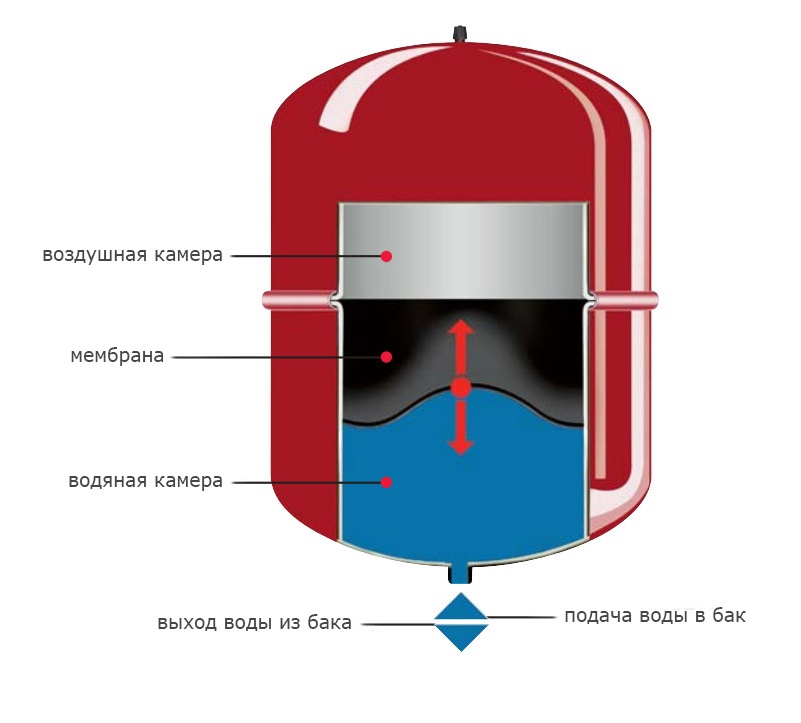
More common and economical is a closed two-pipe heating system with forced circulation. For its correct functioning, additional devices must be installed.
In contrast to open, closed systems do not have contact with the atmosphere. To monitor the increase and decrease of the volume of the heat carrier, a membrane expansion tank is used. It is a sealed container, internally divided into two parts by a flexible membrane. One of the parts is filled with air or nitrogen under pressure. The second one is connected to the heating circuit pipes. This design successfully compensates for the sudden increase or decrease in pressure in the pipes, preventing breakdowns due to sudden overloads. The size of the tank is selected in a volume comparable to the thermal expansion of the coolant in the system. Approximately 10% of the total amount of coolant. It is necessary to control the pressure in the heating system in accordance with the design requirements of the boiler and pump.
Diaphragm tank for heating - installation
The expansion vessel must be pumped up to the design pressure before installation or checked. manufacturers, as a rule, supply already inflated membrane tanks. In domestic systems, the pressure fluctuates around 2-2.5 bar, but does not exceed 4 bar. Where to install the tank? To the pump on the return, closer to the boiler. In the case of an emergency increase in pressure in the pipes, more than the membrane expansion tank can withstand, a safety valve is necessarily installed.
Automatic air vent
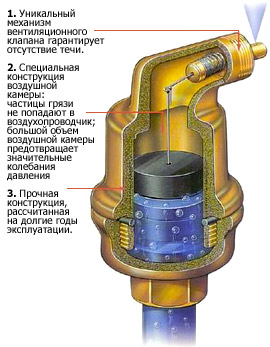
It is very simple. Simpler, the device can be described as a flask with a float. When air accumulates in the flask, the float descends and opens the valve for air. The heat medium under pressure fills the flask, raising the float and locking the valve. The most practical models - with a shut-off valve, which makes it possible to freely screw - unscrew the air vent without spilling the coolant. Because of poor-quality coolant, the air separator can fail more often than other elements of the boiler house. All faults of this node are manifested as a leak and are caused by two reasons:
- The needle is clogged with hardness salts. It is eliminated by the cleaning of the needle and the rocker mechanism. It is enough to unscrew the lid, after the stripping, collect everything.
- Breaking the integrity of the gasket (ring) under the housing cover. Change the gasket, or on the thread, which fastens the lid, make several turns of the tape.
Removal of air should be provided and in other places of the outline - on risers, combs and each heating device. Recently, on the radiators, instead of the usual valve of Majewski, angular automatic air separators began to be installed. This is important for heating circuits that have been installed long ago and incorrectly. In order not to suffer, regularly bleeding air from the pipes, it is better to put an automatic air vent. An important detail - during installation, make sure that the nipple is pointing upwards, otherwise the float will not work.
All modern technologies and design solutions are aimed at reducing operating costs for space heating - reducing fuel consumption, reducing the cost of maintenance. But the most unpleasant thing is that, no matter how much fuel consumption is reduced, no matter how cheap a fuel is found, we have to pay for it, and the burned fuel will give us less than half the heat received according to the laws of thermodynamics. It is sad.
There is a solution when you do not need to pay for fuel and the cost of maintenance equipment will be a mere trifle. This is geothermal.

Heat pump - working principle
Any refrigerator, taking heat from a closed volume, gives it to the environment. The heat pump, on the contrary, takes heat from the environment, cooling it, and pumps it into the closed volume of the house. This is the case: a well was drilled in the area near the house, or a trench was dug below 1 m, where the pipes were laid. At this depth, the temperature is practically constant and is about 10 ° C. The water is pumped through the pumps and gets the same temperature as the earth. In the house, in a special heat exchanger tank, water transfers the temperature of the earth to freon. Then freon is compressed by the compressor and from compression is heated up to 60 0 C. In the other device - the condenser - it gives these 60 0 С to the heating system of the house. Then the cold gas is again heated to 10 0 C and the cycle is repeated.
This is a very primitive description, but the point is that energy (electric) is spent only on pumping water through underground pipelines, compressor operation and forced coolant circulation. 1 kW of electricity consumed brings about 3.5-4.5 kilowatts of land heat to the house. Therefore, it is said that the efficiency of the heat pump is higher than 100%. Heating systems based on a heat pump have a lot of good properties:
- They are noiseless as a refrigerator
- Fireproof
- Have a long service life (up to 50 years of well, up to 20 years of equipment)
- Easily Automated
- One and the same equipment heats in winter, air-conditioning in the summer
- No harmful emissions
Boiler
So, the payback period of the heat pump in comparison with other options for obtaining heat is 3-7 years, and taking into account the constant increase in energy prices, there may be even less. If we receive electricity from renewable sources, complete autonomy of heating and zero operating costs will be ensured.

